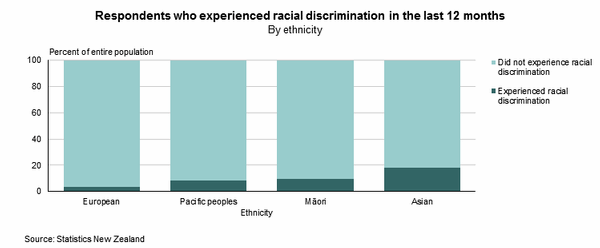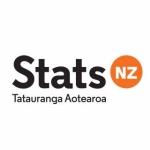Working together: Racial discrimination in New Zealand



This short report uses data from the New Zealand General Social Survey (NZGSS) to look at whether New Zealanders feel racially discriminated against. It also provides background data on overall levels of perceived discrimination and where this takes place.
Read the report online or download and print the PDF from 'Available files' above. If you have problems viewing the file, see Opening files and PDFs.
Ten percent of New Zealanders feel discriminated against
The Human Rights Act 1993 protects people in New Zealand from discrimination in a number of areas of life. Discrimination occurs when a person is treated unfairly, or less favourably, than another person in the same or similar circumstances.
The NZGSS asked New Zealanders (aged 15 years or over) whether they felt discriminated against over the past year. This report uses combined data from the 2008 and 2010 General Social Surveys and is therefore based on a sample of 17,271 respondents.
One in ten people aged 15 years or over reported experiencing some form of discrimination in the last 12 months. This equates to an estimated 343,000 New Zealanders. The graph below shows the reasons why people felt they had been discriminated against.
To be counted as having experienced discrimination, respondents must report that they have been treated unfairly or had something nasty done to them because of the group they belong to or seem to belong to. Respondents could choose as many reasons as they thought relevant.
Racial discrimination is the most common form of discrimination people experience
Six percent of respondents (an estimated 187,000 New Zealanders) believed racial discrimination was the reason for them being treated unfairly or unfavourably.
Two response categories have been combined from the survey to report on racial discrimination. These are ‘skin colour’ and ‘nationality, race, or ethnicity’. It should be noted that the ‘dress or appearance’, ‘religious beliefs’, and ‘language spoken’ reasons may also be factors behind racial discrimination, but as they can be linked to other identity characteristics, they have been kept separate in this report.
The numbers of respondents who felt discriminated against on the basis of their skin colour, nationality, race, or ethnicity allows us to further analyse the data.
Asians report highest levels of racial discrimination
People who identified as Asian reported the highest levels of racial discrimination in any setting, followed by Māori and Pacific peoples, who reported similar levels of racial discrimination. The graph below looks at those who reported experiencing racial discrimination in the last 12 months, in any situation, by ethnicity.
Discrimination most common in employment situations
The places where all types of discrimination are most likely to happen are outlined in the graph below. Respondents may have experienced discrimination in more than one place/situation and all reported places are counted in the survey.
People surveyed in the NZGSS reported that the highest levels of discrimination occurred in employment settings. Overall, 4.3 percent (or an estimated 143,000 New Zealanders) said they had been discriminated against, either while at work, or when working or while applying for (or keeping) a job or position. This was followed by 4.0 percent of respondents (or an estimated 136,000 New Zealanders) who felt they had been discriminated against while on the street or in a public place.
Spotlight on racial discrimination at work
An estimated 77,700 people, or 2.3 percent of respondents, reported experiencing racial discrimination in employment situations (while working or when applying for/keeping a job). This rate is similar to those who have experienced racial discrimination while on the street or in a public place, with 2.5 percent of respondents (an estimated 85,200 New Zealanders) reporting this.
The findings on racial discrimination in the workplace are of particular interest to those monitoring human rights, because New Zealand employers are obliged to provide a safe working environment for their employees. Employees are protected from racial discrimination under the Human Rights Act 1993, and the Employment Relations Act 2000 introduced processes for monitoring and reporting racial discrimination in the workplace.
When looking specifically at the working age population in the survey (defined as those aged 18–65), 2.0 percent of respondents (or an estimated 64,100 people) reported experiencing racial discrimination at work or while working in the past 12 months.
Statistical modelling based on this group of people, shows that Māori, Pacific, and Asian peoples are all more likely to report experiencing racial discrimination in the workplace than the majority group (Europeans).
Migrants are more likely to experience racial discrimination in the workplace than non-migrants (people born in New Zealand). Racial discrimination is not only associated with a person’s ethnic group, but also whether or not they were born in New Zealand.
People who hold a formal qualification (secondary school, trade, or university) are more likely to report racial discrimination in the workplace than those with no qualifications. When applying the same statistical model to racial discrimination in a public place and to overall racial discrimination, having a qualification does not mean that you are more likely to report experiencing racial discrimination.
Methodology
The data is pooled from the 2008 and 2010 NZGSS. This larger sample size helps reduce statistical error in analysis and makes additional research questions feasible. The variables of interest have been tested (using estimates and residual standard errors) to ensure there are no significant statistical differences between the surveys. Weights for the pooled data set are created by dividing the existing weights by two.
A logistic regression model was used to determine the relationship between the explanatory variables and the response variable. Regression models describe how the response variable changes according to the changes in values of explanatory or predictor variables. Since the experience of racial discrimination in the workplace was measured using a binary response variable (yes, no) an ordinary least squares regression could not be used. Instead, a logistic regression was used to measure the relationship between the explanatory variables and the response variable.
The explanatory variables were based on demographic indicators including sex, age, ethnicity, migrant status, and highest qualification.
ISBN 978-0-478-377880-0
Published 10 September 2012
